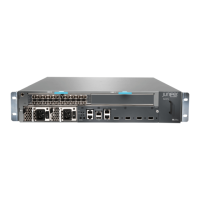
Do you have a question about the Juniper MX10 and is the answer not in the manual?
| Brand | Juniper |
|---|---|
| Model | MX10 |
| Category | Network Router |
| Language | English |
Overview of Juniper Networks 3D Universal Edge Routers, their capabilities, and architecture.
Lists the various MX5, MX10, MX40, and MX80 router models and provides a brief description.
Details hardware components and their corresponding CLI names for the MX series routers.
Describes the physical structure that houses router components, including dimensions.
Describes the front panel components and status indicators on the routers.
Explains the function of critical and warning alarm LEDs on the front panel.
Identifies LEDs on various router components for status and troubleshooting.
Summarizes the physical specifications for the router, including dimensions and weight.
Details environmental specifications for normal router operation.
Provides requirements for grounding the router for safety and EMI.
Summarizes tasks for preparing a site for router installation.
Lists AC power system electrical specifications.
Provides power consumption figures for AC-powered routers.
Specifies circuit breaker requirements for AC power feeds.
Lists DC power system electrical specifications.
Details power consumption for DC-powered routers.
Specifies requirements for DC power cables.
Guides on finding supported optical transceivers using the Hardware Compatibility Tool.
Explains signal loss, attenuation, and dispersion in fiber-optic cables.
Provides methods to calculate power budget and margin for fiber-optic links.
Details RJ-45 connector pinouts for console and auxiliary ports.
Details RJ-45 connector pinouts for the Ethernet management port.
Lists necessary tools and parts for unpacking the router.
Guides on checking received router components against the packing list.
Instructions for installing the cable management bracket on the router.
Steps to reposition mounting brackets for center-mounting the router.
Provides a summary of the router installation process.
Details the procedure for installing the router chassis into a rack.
Lists tools and parts for grounding and power connections.
Provides instructions for properly grounding the router.
Step-by-step guide to connect AC power to the router.
Step-by-step guide to connect DC power to the router.
Lists tools and parts for connecting routers to management devices and line cards.
Guides on connecting the router to management devices.
Instructions for connecting physical interfaces to the network.
Step-by-step guide for the initial configuration of the router using CLI.
Procedure for installing the air filter into the fan tray.
Instructions for replacing the air filter.
Procedure for installing the fan tray into the chassis.
Instructions for replacing the fan tray.
Steps to install a Modular Interface Card (MIC) into the router.
Instructions for removing and replacing a MIC.
Procedure for installing optical transceivers (SFP/XFP).
Instructions for replacing SFPs or XFPs.
Procedure for installing an AC power supply.
Instructions for replacing an AC power supply.
Procedure for installing a DC power supply.
Instructions for replacing a DC power supply.
Lists tools and parts for hardware maintenance.
Outlines preventive maintenance procedures for routers.
Guides on inspecting and maintaining the air filter.
Guides on verifying the condition of the fan tray.
Guides on verifying the condition of MICs.
Lists resources for troubleshooting router components.
Explains the CLI as a primary tool for troubleshooting.
Describes how alarm messages indicate issues with chassis or interfaces.
Explains the function of front panel LEDs for troubleshooting.
Information on how to contact Juniper Networks Technical Assistance Center (JTAC).
Instructions on how to display component serial numbers using CLI.
Describes the location of the chassis serial number label.
Details the location of MIC serial number labels.
Describes the location of power supply serial number labels.
Steps to contact support for RMA.
Provides guidelines for packing hardware components for safe shipment.
Specific instructions for packing routers for shipment.
General safety procedures to ensure user safety and prevent device damage.
Explains different levels of safety warnings used in the document.
Warns that only trained personnel should install or replace the device.
Outlines procedures and equipment for fire emergencies.
Guidelines to minimize ESD damage to components.
Emphasizes reading installation instructions before connecting power.
Provides guidelines for safely lifting and moving the router chassis.
Precautions for stable and safe mounting of the device in racks or cabinets.
Guidelines for safe operation around laser and LED components.
Safety guidelines to prevent eye injury when working with optical transceivers.
Warns about invisible radiation from open ports.
General safety guidelines during maintenance activities.
Warning regarding safe battery replacement and disposal.
Caution to remove metal jewelry before working on powered equipment.
Advises against working on the system during lightning activity.
Warning about operating the device within recommended ambient temperature limits.
General electrical safety guidelines to ensure safe operation.
Measures to prevent ESD damage to sensitive components.
Safety guidelines specific to AC-powered devices.
Instructions for safely disconnecting DC power.
Critical information on the correct DC power wiring sequence.
Lists the safety and EMC standards the routers comply with.
Details EMC compliance statements for various regions.
Information on environmental compliance, e.g., battery substances.
Statements regarding compliance with NEBS requirements.